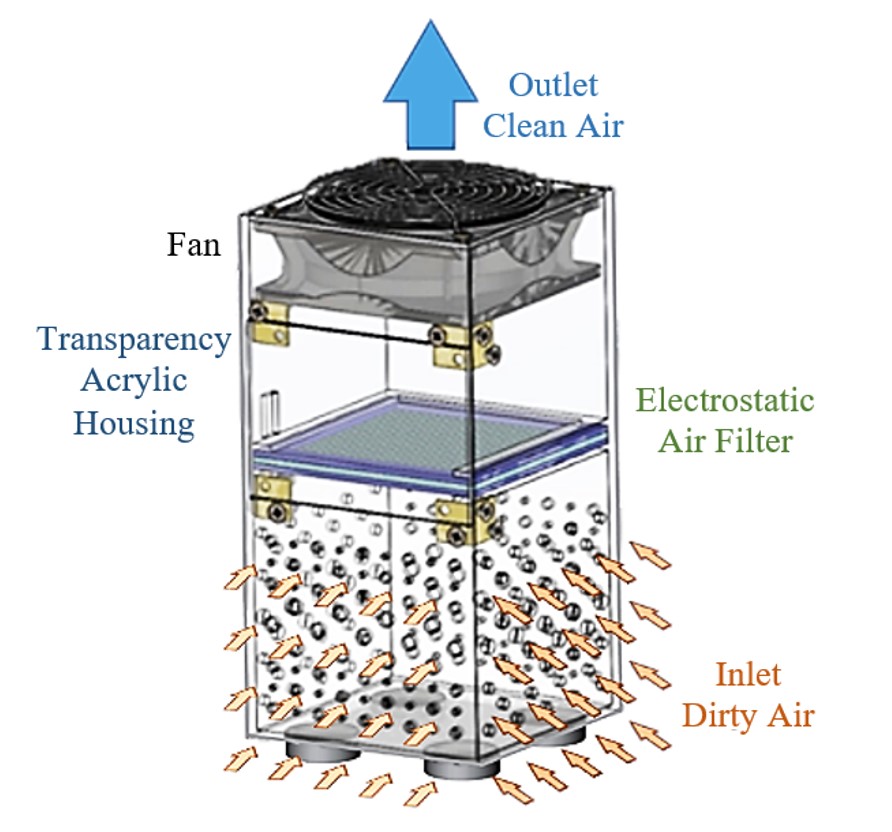The Optimization of Electrostatic Air Filter Layers for Small Dust Particles Reduced
Main Article Content
Abstract
Air pollution, stemming from natural and industrial sources, necessitates effective air purification methods. Electrostatic air filters offer an eco-friendly alternative to high-efficiency particulate air (HEPA) filters, characterized by low pressure drop, minimal noise, cost-efficiency, and reusability. This study investigates the enhancement of electrostatic air filter performance by increasing layer count. Experimental tests in a 1×1×1 m3 chamber, using small dust particles (1 µm, 2.5 µm, and 10 µm), reveal that adding layers significantly improves filtration efficiency. Optimal layer counts of 5, 5, and 4 for respective particle sizes maintain compliance with ASHRAE 52.2 MERV Rating 14 standards. According to ISO16890 standards, these filters require maintenance or replacement after 72 cycles when efficiency falls below 60%. This research promotes wider adoption of electrostatic filters for health benefits and energy conservation.
Article Details

This work is licensed under a Creative Commons Attribution-NonCommercial-ShareAlike 4.0 International License.
This work is licensed under a Creative Commons Attribution-NonCommercial-ShareAlike 4.0 International License.
References
World Health Organization. WHO global air quality guidelines. Particulate matter (PM2.5 and PM10), ozone, nitrogen dioxide, sulfur dioxide and carbon monoxide. Geneva: World Health Organization; 2021.
World Health Organization. Ambient air pollution: A global assessment of exposure and burden of disease. Geneva: World Health Organization; 2016.
Liu DT, Phillips KM, Speth MM, Besser G, Mueller CA, Sedaghat AR. Portable HEPA purifiers to eliminate airborne SARS-CoV-2: a systematic review. Otolaryngol Head Neck Surg. 2022;166(4):615-622.
Frederick ER. Fibers, electrostatics, and filtration: a review of new technology. J Air Pollut Control Assoc. 1980;30(4):426-431.
Ardkapan SR, Johnson MS, Yazdi S, Afshari A, Bergsøe NC. Filtration efficiency of an electrostatic fibrous filter: studying filtration dependency on ultrafine particle exposure and composition. J Aerosol Sci. 2014;72:14-20.
Kilic A, Russell S, Shim E, Pourdeyhimi B. The charging and stability of electret filters. In: Brown PJ, Cox CL, editors. Fibrous Filter Media. Cambridge: Woodhead Publishing; 2017. p. 95-121.
Xu R. Light scattering: a review of particle characterization applications. Particuology. 2015;18:11-21.
Asanavijit V, Intra P, Rattanachan W, Hansapiromchoke P. Evaluation of the filtration efficiency of aerosol particles of the commercial air purifiers for indoor use. Ladkrabang Eng J. 2021;38(4):166-177. (In Thai)



